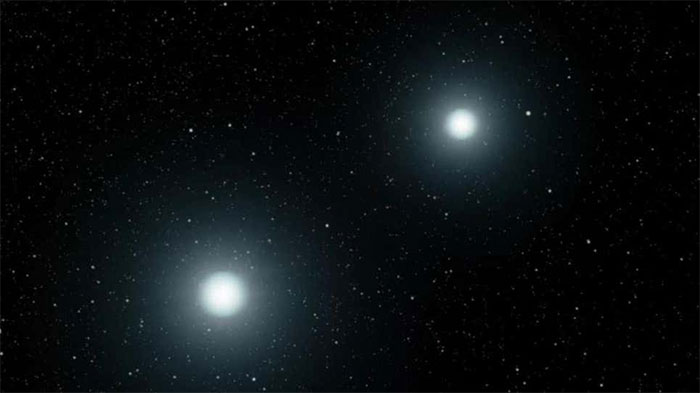A group of German astronomers has recently discovered a cluster of unusual stars, covered in ash from the process of helium burning.
The research, led by Professor Klaus Werner from the University of Tübingen (Germany), has been published in the monthly scientific journal on astronomy and astrophysics by Oxford University Press. The study reveals that the newly discovered stars have surfaces covered with carbon, oxygen, and ash from the burning of helium gas, while typical stars have surfaces composed of hydrogen and helium gases.

Two white dwarf stars in the process of merging. (Image credit: NASA)
What is difficult to explain is that the temperature and radius of these new stars indicate they are still burning helium in their cores—a characteristic typically seen in stars that are more evolved than those previously observed by the research team.
Alongside Professor Werner’s research, a second study conducted by a group of astronomers from the University of La Plata (Argentina) and the Max Planck Institute for Astrophysics (Germany) has provided a plausible explanation for the formation of these new stars.
Dr. Miller Bertolami from the University of La Plata, the lead author of the second report, stated that his team believes the stars discovered by the German scientists may have formed from a very rare merger event between two white dwarf stars. White dwarfs are celestial objects created when low- to medium-mass stars “die,” meaning they have exhausted their nuclear fuel in their cores (all hydrogen has been converted to helium).
These merger events are thought to occur between white dwarfs in close binary star systems when their orbits are shrunk by gravitational waves.
According to Dr. Bertolami, typically, the merging of white dwarfs does not lead to the formation of carbon- and oxygen-rich stars. However, his team believes that for binary star systems formed with specific masses, a carbon- and oxygen-rich white dwarf could be disrupted and end up on top of a helium-rich star, leading to the formation of these unique new stars.
Despite this, no current stellar evolution models can fully explain the newly discovered stars. Researchers need refined models to assess whether stellar mergers actually occur. These models not only help scientists gain a better understanding of the new stars but also provide deeper insights into the late development of binary star systems and how stars exchange mass during evolution. Therefore, the origins of stars covered in helium will remain a topic of debate until new stellar evolution models are developed.
Professor Werner noted that the research team hopes the surfaces of these new stars have completed the helium burning process in their cores and are gradually becoming white dwarfs. The professor emphasized: “These new stars present a significant challenge to humanity in understanding the evolution of stars.”


















































